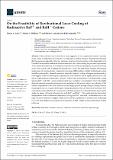| dc.contributor.author | Isaev, Timur A. | |
| dc.contributor.author | Wilkins, Shane G. | |
| dc.contributor.author | Athanasakis-Kaklamanakis, Michail | |
| dc.date.accessioned | 2022-01-06T16:26:34Z | |
| dc.date.available | 2021-12-09T20:14:32Z | |
| dc.date.available | 2022-01-06T16:26:34Z | |
| dc.date.issued | 2021-11-26 | |
| dc.identifier.uri | https://hdl.handle.net/1721.1/138411.2 | |
| dc.description.abstract | Polar radioactive molecules have been suggested to be exceptionally sensitive systems
in the search for signatures of symmetry-violating effects in their structure. Radium monofluoride
(RaF) possesses an especially attractive electronic structure for such searches, as the diagonality of its
Franck-Condon matrix enables the implementation of direct laser cooling for precision experiments.
To maximize the sensitivity of experiments with short-lived RaF isotopologues, the molecular beam
needs to be cooled to the rovibrational ground state. Due to the high kinetic energies and internal
temperature of extracted beams at radioactive ion beam (RIB) facilities, in-flight rovibrational cooling
would be restricted by a limited interaction timescale. Instead, cooling techniques implemented on
ions trapped within a radiofrequency quadrupole cooler-buncher can be highly efficient due to the
much longer interaction times (up to seconds). In this work, the feasibility of rovibrationally cooling
trapped RaF+ and RaH+ cations with repeated laser excitation is investigated. Due to the highly
diagonal nature between the ionic ground state and states in the neutral system, any reduction of the
internal temperature of the molecular ions would largely persist through charge-exchange without
requiring the use of cryogenic buffer gas cooling. Quasirelativistic X2C and scalar-relativistic ECP
calculations were performed to calculate the transition energies to excited electronic states and to
study the nature of chemical bonding for both RaF+ and RaH+. The results indicate that optical
manipulation of the rovibrational distribution of trapped RaF+ and RaH+ is unfeasible due to the
high electronic transition energies, which lie beyond the capabilities of modern laser technology.
However, more detailed calculations of the structure of RaH+ might reveal possible laser-cooling
pathways. | en_US |
| dc.publisher | Multidisciplinary Digital Publishing Institute | en_US |
| dc.relation.isversionof | http://dx.doi.org/10.3390/atoms9040101 | en_US |
| dc.rights | Creative Commons Attribution | en_US |
| dc.rights.uri | https://creativecommons.org/licenses/by/4.0/ | en_US |
| dc.source | Multidisciplinary Digital Publishing Institute | en_US |
| dc.title | On the Feasibility of Rovibrational Laser Cooling of Radioactive RaF+ and RaH+ Cations | en_US |
| dc.type | Article | en_US |
| dc.identifier.citation | Atoms 9 (4): 101 (2021) | en_US |
| dc.contributor.department | Massachusetts Institute of Technology. Laboratory for Nuclear Science | en_US |
| dc.eprint.version | Final published version | en_US |
| dc.type.uri | http://purl.org/eprint/type/JournalArticle | en_US |
| eprint.status | http://purl.org/eprint/status/PeerReviewed | en_US |
| dc.date.updated | 2021-12-09T14:32:13Z | |
| dspace.date.submission | 2021-12-09T14:32:13Z | |
| mit.license | PUBLISHER_CC | |
| mit.metadata.status | Publication Information Needed | en_US |
